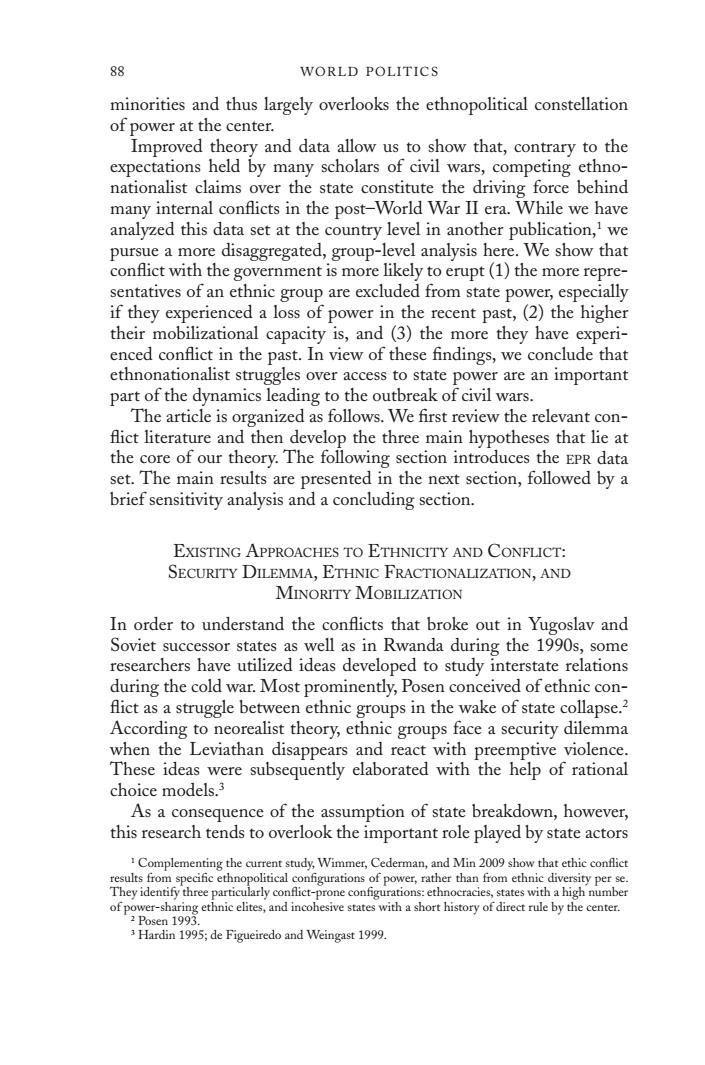正在加载图片...

88 WORLD POLITICS minorities and thus largely overlooks the ethnopolitical constellation of power at the center. Improved theory and data allow us to show that,contrary to the expectations held by many scholars of civil wars,competing ethno- nationalist claims over the state constitute the driving force behind many internal conflicts in the post-World War II era.While we have analyzed this data set at the country level in another publication,we pursue a more disaggregated,group-level analysis here.We show that conflict with the government is more likely to erupt(1)the more repre- sentatives of an ethnic group are excluded from state power,especially if they experienced a loss of power in the recent past,(2)the higher their mobilizational capacity is,and(3)the more they have experi- enced confict in the past.In view of these findings,we conclude that ethnonationalist struggles over access to state power are an important part of the dynamics leading to the outbreak of civil wars. The article is organized as follows.We first review the relevant con- flict literature and then develop the three main hypotheses that lie at the core of our theory.The following section introduces the EPR data set.The main results are presented in the next section,followed by a brief sensitivity analysis and a concluding section. EXISTING APPROACHES TO ETHNICITY AND CONFLICT: SECURITY DILEMMA,ETHNIC FRACTIONALIZATION,AND MINORITY MOBILIZATION In order to understand the conflicts that broke out in Yugoslav and Soviet successor states as well as in Rwanda during the 1990s,some researchers have utilized ideas developed to study interstate relations during the cold war.Most prominently,Posen conceived of ethnic con- flict as a struggle between ethnic groups in the wake of state collapse.2 According to neorealist theory,ethnic groups face a security dilemma when the Leviathan disappears and react with preemptive violence. These ideas were subsequently elaborated with the help of rational choice models.3 As a consequence of the assumption of state breakdown,however, this research tends to overlook the important role played by state actors Complementing the current study,Wimmer,Cederman,and Min 2009 show that ethic conflict results from specific ethnopolitical configurations of power,rather than from ethnic diversity per se. They identify three particularly conflict-prone configurations:ethnocracies,states with a high number of power-sharing ethnic elites,and incohesive states with a short history of direct rule by the center. 2 Posen 1993. 3 Hardin 1995;de Figueiredo and Weingast 1999.88 world politics 1 Complementing the current study, Wimmer, Cederman, and Min 2009 show that ethic conflict results from specific ethnopolitical configurations of power, rather than from ethnic diversity per se. They identify three particularly conflict-prone configurations: ethnocracies, states with a high number of power-sharing ethnic elites, and incohesive states with a short history of direct rule by the center. 2 Posen 1993. 3 Hardin 1995; de Figueiredo and Weingast 1999. minorities and thus largely overlooks the ethnopolitical constellation of power at the center. Improved theory and data allow us to show that, contrary to the expectations held by many scholars of civil wars, competing ethnonationalist claims over the state constitute the driving force behind many internal conflicts in the post–World War II era. While we have analyzed this data set at the country level in another publication,1 we pursue a more disaggregated, group-level analysis here. We show that conflict with the government is more likely to erupt (1) the more representatives of an ethnic group are excluded from state power, especially if they experienced a loss of power in the recent past, (2) the higher their mobilizational capacity is, and (3) the more they have experienced conflict in the past. In view of these findings, we conclude that ethnonationalist struggles over access to state power are an important part of the dynamics leading to the outbreak of civil wars. The article is organized as follows. We first review the relevant conflict literature and then develop the three main hypotheses that lie at the core of our theory. The following section introduces the epr data set. The main results are presented in the next section, followed by a brief sensitivity analysis and a concluding section. Existing Approaches to Ethnicity and Conflict: Security Dilemma, Ethnic Fractionalization, and Minority Mobilization In order to understand the conflicts that broke out in Yugoslav and Soviet successor states as well as in Rwanda during the 1990s, some researchers have utilized ideas developed to study interstate relations during the cold war. Most prominently, Posen conceived of ethnic conflict as a struggle between ethnic groups in the wake of state collapse.2 According to neorealist theory, ethnic groups face a security dilemma when the Leviathan disappears and react with preemptive violence. These ideas were subsequently elaborated with the help of rational choice models.3 As a consequence of the assumption of state breakdown, however, this research tends to overlook the important role played by state actors